| After many days of walking, laughing at all Derek's
& everyone else's terrible jokes & sleeping in
tents, we moved on. The bus was waiting for us on the
highway & accompanied by our Sirdar Rinji & 2
guides, Chhiring & Dilli, we took to the highway
again, back part way on the road we had arrived on 9 days
before. We took the road south to Chitwan along a fast
moving river where we saw several rafts on the river side
waiting to start the morning rafting adventure. It looked
like fun. The road we were on was high above the river
& just as winding as before with several washed out
areas and attempts at repair. Passed the main town for
that area where we spied a cremation taking place on the
river bank. Reached a police checkpoint and after a delay
while the directions to our lodge were straightened out,
we reached the Tharu Village Lodge & checked in.
There was a mixup in the reservations & the Village
Lodge was over booked, so Ian & Pat volunteered to
proceed to the Jungle Lodge for 2 nights. The rest of us
drew lots for 3 rooms: 3 women in one, 3 men in another
& one couple in the 3rd. It was all rather fun as the
rooms were all spacious and had a full bathroom with a
real toilet. What luxury. We had a good Nepali lunch
beside the swimming pool, then hit the gift shop to buy t-shirts,
shorts & a few souvenirs. Just had time for a short
swim in the pool before joining a naturalist on a nature
walk through the forest. Got driven to the start of the
walk on an ox cart across a small stream. Didn't see any
rhinos yet, but did see a fish eating crocodile sunning
on the river bank and some monkeys, deer & birds.
This village is on the buffer zone for the Chitwan
jungle, a national forest and game preserve. Most of the
food for the lodges is grown using organic methods by the
villagers who live surrounding the resort. After a good
continental style dinner, we were treated to more dancing.
This time a group in Tharu native costume who performed
to different music that we heard previously. Like some of
our evenings, the group made sure everyone got up with
them & tried out the steps. It was fun.
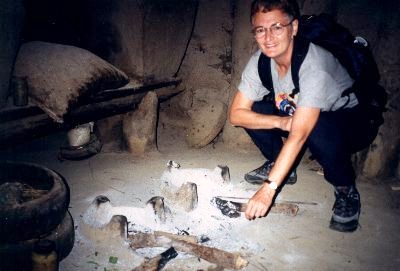 The next
morning, there was a delay in transferring us to the
Jungle Lodge for our 2nd night, so some of us took a w
alking tour through the Tharu village. It was almost a
show village, most of it cleaner than the ones we had
passed through on our walks, but still primitive with no
running water or electricity. The wealth of the
inhabitants is indicated by their roof, from straw thatch
to tin to a few that were tiled. Went inside one home,
apparently lived in by a staff member, that looked quite
large. Some of the young men were having their morning
bath at the family water pump in the front yard. They
strip down to their undies & do a good job of soaping
down & washing their hair. The
house had a common living room & a
traditional kitchen on the ground floor; dirt floor, very
small windows and double open fireplace in the kitchen
but no chimney to let out the smok e which still hung in
the room. Upstairs were 2 bedrooms & a storage room
above the kitchen. The people sleep on straw mats which
were neatly rolled up & have cotton filled comforters
for warmth. The house seemed large until you discover
that 12 people live there. Took the ox cart, then a river
boat (no motor) and a jeep ride to the Tiger Tops Jungle
Lodge. Pat & Ian were there & all excited about
their stay. They had already been out on an elephant ride
& seen a mother Rhino with her baby. Also had shared
the lodge the night before with a group of 46 on a 21 day
'Lost cities of the World' excursion, travelling in 2
private jets at a cost of $35,000 USD each. Even so, they
were rather rushed from one place to the next & only
had the 1 night at Tiger Tops. The next
morning, there was a delay in transferring us to the
Jungle Lodge for our 2nd night, so some of us took a w
alking tour through the Tharu village. It was almost a
show village, most of it cleaner than the ones we had
passed through on our walks, but still primitive with no
running water or electricity. The wealth of the
inhabitants is indicated by their roof, from straw thatch
to tin to a few that were tiled. Went inside one home,
apparently lived in by a staff member, that looked quite
large. Some of the young men were having their morning
bath at the family water pump in the front yard. They
strip down to their undies & do a good job of soaping
down & washing their hair. The
house had a common living room & a
traditional kitchen on the ground floor; dirt floor, very
small windows and double open fireplace in the kitchen
but no chimney to let out the smok e which still hung in
the room. Upstairs were 2 bedrooms & a storage room
above the kitchen. The people sleep on straw mats which
were neatly rolled up & have cotton filled comforters
for warmth. The house seemed large until you discover
that 12 people live there. Took the ox cart, then a river
boat (no motor) and a jeep ride to the Tiger Tops Jungle
Lodge. Pat & Ian were there & all excited about
their stay. They had already been out on an elephant ride
& seen a mother Rhino with her baby. Also had shared
the lodge the night before with a group of 46 on a 21 day
'Lost cities of the World' excursion, travelling in 2
private jets at a cost of $35,000 USD each. Even so, they
were rather rushed from one place to the next & only
had the 1 night at Tiger Tops.
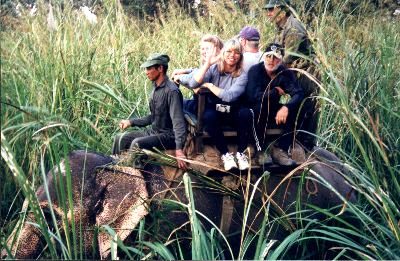 We had lunch, then checked into our rooms in cottages
on the property. Our large room opened up into a living
room shared by Derek & Josie. Just time to get
organized & attend an elephant briefing given by one
of the naturalists & elephant handlers. They have 10
Indian elephants at the lodge, 2 males called Tuskers
& 8 females. One male was born at Tiger Tops 21 years
ago, the only baby so far. Very interesting talk. Next we
all went on our first elephant ride out to the grasses.
We sat 4 to an elephant in a seat like a playpen on the
elephant's back with the handler riding
behind the head guiding the elephant with his bare feet
behind her ears. Once you learned to roll with the
elephant's gait, it was comfortable enough. Saw a one
horned rhino, then we turned off at a spot the handler
said there had been a kill by a tiger. The baby rhino was
the victim & the tiger was still around enjoying his
meal. As we got close to the spot, the elephants each
emmitted a low rumbling sound that reverberat ed in their
heads and several trumpeted their displeasure. All of the
elephants have met up with a tiger at one time or another
& are not that keen on them, even though they are
much bigger. All of a sudden the tiger jumped from his
hiding place, but all I saw was the grasses move. We
stuck around for a while but the tiger was well hidden. We had lunch, then checked into our rooms in cottages
on the property. Our large room opened up into a living
room shared by Derek & Josie. Just time to get
organized & attend an elephant briefing given by one
of the naturalists & elephant handlers. They have 10
Indian elephants at the lodge, 2 males called Tuskers
& 8 females. One male was born at Tiger Tops 21 years
ago, the only baby so far. Very interesting talk. Next we
all went on our first elephant ride out to the grasses.
We sat 4 to an elephant in a seat like a playpen on the
elephant's back with the handler riding
behind the head guiding the elephant with his bare feet
behind her ears. Once you learned to roll with the
elephant's gait, it was comfortable enough. Saw a one
horned rhino, then we turned off at a spot the handler
said there had been a kill by a tiger. The baby rhino was
the victim & the tiger was still around enjoying his
meal. As we got close to the spot, the elephants each
emmitted a low rumbling sound that reverberat ed in their
heads and several trumpeted their displeasure. All of the
elephants have met up with a tiger at one time or another
& are not that keen on them, even though they are
much bigger. All of a sudden the tiger jumped from his
hiding place, but all I saw was the grasses move. We
stuck around for a while but the tiger was well hidden.
Had an elegant candlelight dinner of quail in the
dining lodge, then retired early to bed because we had
booked to go again on an elephant ride at 6:30 AM, which
came early enough. Started out in the morning in heavy
mist, back to the same spot as the day before. The baby
rhino carcass was still there and so was the tiger. This
time most of us were able to just see the tiger hiding in
the grasses. The elephants circled the tiger, but were
not pleased doing this. My elephant tried to go the other
way and had to be persuaded by her handler to stick
around. The handlers tried to flush out the tiger again
without hurting him or destroying too much of his cover,
but he stuck his ground. It was exciting anyway.
We had planned to walk to the Tented Village, our last
stop at Tiger Tops, but because the tiger was still
around, we were driven part way in a jeep. We got out
next to a river with 2 guides and after reconstructing
the partly destroyed walkway, crossed to the other side
& started up the path. Just a short distance away was
an elephant eating in the trees. One of the guides went
ahead to investigate & returned quickly with a look
of fear on his face. He said it was a wild elephant that
had stayed into the area & he wasn't taking any
chances. We had to make a detour by clambering up a steep
bank in the opposite direction. The guides were not
wasting any time getting us out of there. We walked the
rest of the way safely, arriving in time for lunch again.
This lodge has no electricity at all. Each tent is
very large with twin or queen sized bed and a private
patio overlooking the elephant grasses below. The
bathroom is separated from the tent by about 3 f eet but
had running water & a solar powered shower.
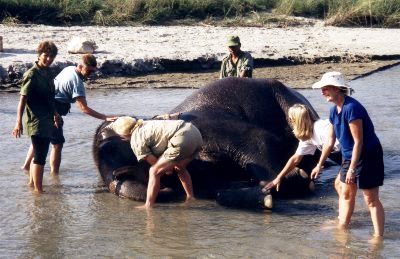 In the afternoon we chose between a river boat cruise
or a jeep game drive. We all started by walking down to
the river where one of their 3 elephants was led out to be bathed. We were
invited to get in the river & help bathe the elephant
so all the women in our group took their shoes off &
waded in. It was fun finding out what an elephant felt
like, lots of wrinkled skin & soft spongy foot
bottoms. The elephant just lay back & enjoyed the
attention. Ray & I chose the jeep ride which was
rather long & didn't yield any more tigers, but was
interesting for the birds - parakeets, black stork,
peacock, jungle babblers - deer, rhinos & rhesus
monkeys. We returned after dark and found the way to our
tent by flashlight & kerosene lamp left outdie our
tent and in the bathroom. Dinner was a shish kebab
barbeque cooked outside their dining lodge. We were
joined by the current manager, a 30ish english women, who
seemed to like our company. She said were the youngest
& livliest group in a long time! And we thought we
were all rather aged. In the afternoon we chose between a river boat cruise
or a jeep game drive. We all started by walking down to
the river where one of their 3 elephants was led out to be bathed. We were
invited to get in the river & help bathe the elephant
so all the women in our group took their shoes off &
waded in. It was fun finding out what an elephant felt
like, lots of wrinkled skin & soft spongy foot
bottoms. The elephant just lay back & enjoyed the
attention. Ray & I chose the jeep ride which was
rather long & didn't yield any more tigers, but was
interesting for the birds - parakeets, black stork,
peacock, jungle babblers - deer, rhinos & rhesus
monkeys. We returned after dark and found the way to our
tent by flashlight & kerosene lamp left outdie our
tent and in the bathroom. Dinner was a shish kebab
barbeque cooked outside their dining lodge. We were
joined by the current manager, a 30ish english women, who
seemed to like our company. She said were the youngest
& livliest group in a long time! And we thought we
were all rather aged.
The next morning, we couldn't resist one more elephant
ride before leaving. Out in the mist again, so heavy it
seems that it is raining, but no tigers this time. There
is a mother & cubs near the tented village but she
was not to be seen. Instead, Kary n's elephant came upon
a pile of peacock feathers & signs of a fight. The
handler said the mother was teaching her babies to hunt
& got the elephant to delicately pick up all the
feathers & give them to the guests. Quite a souvenir.
After breakfast we left to take a short flight back to
Kathmandu. The view from the small plane is great with
the green hills below & the mountains to the north.
As we approached the city we could pick out Durbar square
with its temples & several other spots. Arrived at
noon, with plenty of time to visit some of the shops
& settle in.
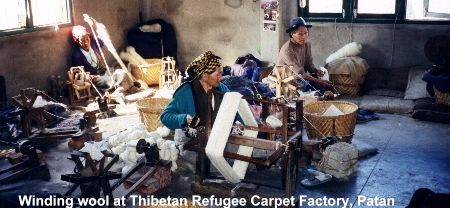 The next morning we walked to Mike's for breakfast,
passing by the King's palace just as a red clad horse
guard rode out the gates pulling 2 coaches. Rather out of
place in this city. After a huge breakfast, we arranged
for taxis to take us to Patan, an ancient town that is
now a suburb of Kathmandu. There we visited the Tibetan
refugee center, where there is a busy rug factory making beautiful wool carpets. We visited the
spinning & weaving halls where mostly women sit on
the floor working diligently. The show room upstairs
captured quite a few of us as the designs & colours
are beautiful & the prices very reasonable. After
buying several, the waiting taxis took us to Patan's
Durbar square where we photograhed the temples &
visited a shop selling singing bowls. Ray discovered this
shop in 1998. The bowls are a metal alloy & when
rubbed with a woden stick emit different resonating
tones, depending on the size. There was even a huge one
that when placed on the head & struck, sent sound
waves from your head to your toes. The next morning we walked to Mike's for breakfast,
passing by the King's palace just as a red clad horse
guard rode out the gates pulling 2 coaches. Rather out of
place in this city. After a huge breakfast, we arranged
for taxis to take us to Patan, an ancient town that is
now a suburb of Kathmandu. There we visited the Tibetan
refugee center, where there is a busy rug factory making beautiful wool carpets. We visited the
spinning & weaving halls where mostly women sit on
the floor working diligently. The show room upstairs
captured quite a few of us as the designs & colours
are beautiful & the prices very reasonable. After
buying several, the waiting taxis took us to Patan's
Durbar square where we photograhed the temples &
visited a shop selling singing bowls. Ray discovered this
shop in 1998. The bowls are a metal alloy & when
rubbed with a woden stick emit different resonating
tones, depending on the size. There was even a huge one
that when placed on the head & struck, sent sound
waves from your head to your toes.
That night we had our farewell dinner at the Thamel
House. We were joined by Nancy & Tashi Sherpa, Gord's
Nepali partner in Everest Trekking, & their 2 boys
aged 5 & 8. We had an excellent Nepali meal &
said our good byes as Karyn & Mike were leaving the
next day.
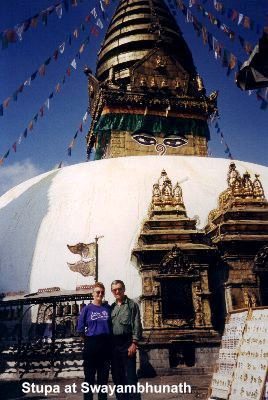 After the rest of our group had flown home, Ray &
I explored more of Kathmandu. We started with a walk to
the old Durbar square where we saw an Indian snake
charmer with a cobra & python. Also revisited the
temple of the Kumari Devi, the living goddess, a young
girl of about 10, who has been the Kumari since she was 5
& will stop at puberty. She made her requisite
appearance at the window complete in full makeup and hair
do. Kind of creepy. We continued on through the real back
streets heading for the Monkey temple Swayambhunath, a
Hindu temple. The streets are teeming with humanity & garbage, but we
walked on without any problems until reaching the very
steep stairs of the temple. The steps for the first half
are lined with souvenir stands & beggars, many
carrying babies, which is a bit of a scam. We ignored
them & puffed our way to the top where we joined lots
of other tourists & many observant Hindus who were
lining up at one of the temples to be blessed. The temple
is on a hill overlooking Kathmandu & gave a good view
of the city, smog & all. Walked around the southern
entrance of the temple & watched a man feed the
monkeys from a bag of bread, causing a near stampede of
at least 50 monkeys of all sizes. After the rest of our group had flown home, Ray &
I explored more of Kathmandu. We started with a walk to
the old Durbar square where we saw an Indian snake
charmer with a cobra & python. Also revisited the
temple of the Kumari Devi, the living goddess, a young
girl of about 10, who has been the Kumari since she was 5
& will stop at puberty. She made her requisite
appearance at the window complete in full makeup and hair
do. Kind of creepy. We continued on through the real back
streets heading for the Monkey temple Swayambhunath, a
Hindu temple. The streets are teeming with humanity & garbage, but we
walked on without any problems until reaching the very
steep stairs of the temple. The steps for the first half
are lined with souvenir stands & beggars, many
carrying babies, which is a bit of a scam. We ignored
them & puffed our way to the top where we joined lots
of other tourists & many observant Hindus who were
lining up at one of the temples to be blessed. The temple
is on a hill overlooking Kathmandu & gave a good view
of the city, smog & all. Walked around the southern
entrance of the temple & watched a man feed the
monkeys from a bag of bread, causing a near stampede of
at least 50 monkeys of all sizes.
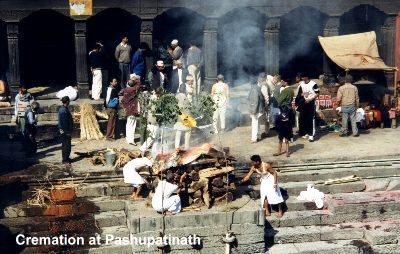 The next day we decided to keep our walking
conditioning up, so we walked about 1.5 hrs to another
Hindu temple, Pashupatinath, on the side of a river. The
main temple is closed to non-Hindus, but you can catch a
glimpse of the famous golden Bull from the door. The
temple was crowded with many Hindu families coming to pay
their respects. We walked to a hill where we could look
down on the temple & observe the many activities
there. Since the river is considered almost as sacred as
the Ganges, it is the site of many cremations. There was a military band on the hill
that started playing the Last Post across from a pyre
covered in a red & gold damask cloth with a canopy
over it. One of the observers said it was a member of the
Nepal Royal family being cremated so that was the reason
for the extra pomp & ceremony. This temple was also
the home of a large monkey population, but we kept our
distance. The next day we decided to keep our walking
conditioning up, so we walked about 1.5 hrs to another
Hindu temple, Pashupatinath, on the side of a river. The
main temple is closed to non-Hindus, but you can catch a
glimpse of the famous golden Bull from the door. The
temple was crowded with many Hindu families coming to pay
their respects. We walked to a hill where we could look
down on the temple & observe the many activities
there. Since the river is considered almost as sacred as
the Ganges, it is the site of many cremations. There was a military band on the hill
that started playing the Last Post across from a pyre
covered in a red & gold damask cloth with a canopy
over it. One of the observers said it was a member of the
Nepal Royal family being cremated so that was the reason
for the extra pomp & ceremony. This temple was also
the home of a large monkey population, but we kept our
distance.
There is Buddhist Stupa, reputed to be one of the
largest in the world, nearby so we decided to visit there
as well. It took us about 30 minutes of walking through
more garbage strewn back alleys to reach it. Welcome to
Kathmandu. The Stupa Bodhnath is the site of the largest
population of Tibetans in Nepal, so there were many shops
selling Tibetan style souvenirs. In fact the Stupa is
ringed with shops in between several active monasteries,
where services were in progress complete with gongs &
drums. We had lunch at the Stupa View restaurant, which
has balconies almost at a level with the top of the
Stupa, so you do get a good view.
Met Gord & Gail Konantz that evening on their
return from 2 weeks visiting the Rajistan region of India.
They had a fabulous time travelling with car & driver
& stayed in restored forts & old Raj palaces.
Nancy & Tashi & boys took us all out to dinner
that night to Chez Caroline, which is in a rather upscale
boutiques style shopping mall, reminiscent of Sedona,
Arizona. We were sorry to say good bye, but we will
return to Kathmandu, probably next year.
|
 The next
morning, there was a delay in transferring us to the
Jungle Lodge for our 2nd night, so some of us took a w
alking tour through the Tharu village. It was almost a
show village, most of it cleaner than the ones we had
passed through on our walks, but still primitive with no
running water or electricity. The wealth of the
inhabitants is indicated by their roof, from straw thatch
to tin to a few that were tiled. Went inside one home,
apparently lived in by a staff member, that looked quite
large. Some of the young men were having their morning
bath at the family water pump in the front yard. They
strip down to their undies & do a good job of soaping
down & washing their hair. The
The next
morning, there was a delay in transferring us to the
Jungle Lodge for our 2nd night, so some of us took a w
alking tour through the Tharu village. It was almost a
show village, most of it cleaner than the ones we had
passed through on our walks, but still primitive with no
running water or electricity. The wealth of the
inhabitants is indicated by their roof, from straw thatch
to tin to a few that were tiled. Went inside one home,
apparently lived in by a staff member, that looked quite
large. Some of the young men were having their morning
bath at the family water pump in the front yard. They
strip down to their undies & do a good job of soaping
down & washing their hair. The  We had lunch, then checked into our rooms in cottages
on the property. Our large room opened up into a living
room shared by Derek & Josie. Just time to get
organized & attend an elephant briefing given by one
of the naturalists & elephant handlers. They have 10
Indian elephants at the lodge, 2 males called Tuskers
& 8 females. One male was born at Tiger Tops 21 years
ago, the only baby so far. Very interesting talk. Next we
all went on our first elephant ride out to the grasses.
We sat 4 to an elephant in a seat like a playpen on the
We had lunch, then checked into our rooms in cottages
on the property. Our large room opened up into a living
room shared by Derek & Josie. Just time to get
organized & attend an elephant briefing given by one
of the naturalists & elephant handlers. They have 10
Indian elephants at the lodge, 2 males called Tuskers
& 8 females. One male was born at Tiger Tops 21 years
ago, the only baby so far. Very interesting talk. Next we
all went on our first elephant ride out to the grasses.
We sat 4 to an elephant in a seat like a playpen on the  In the afternoon we chose between a river boat cruise
or a jeep game drive. We all started by walking down to
the river where one of their 3 elephants
In the afternoon we chose between a river boat cruise
or a jeep game drive. We all started by walking down to
the river where one of their 3 elephants The next morning we walked to Mike's for breakfast,
passing by the King's palace just as a red clad horse
guard rode out the gates pulling 2 coaches. Rather out of
place in this city. After a huge breakfast, we arranged
for taxis to take us to Patan, an ancient town that is
now a suburb of Kathmandu. There we visited the Tibetan
refugee center, where there is a busy rug factory making
The next morning we walked to Mike's for breakfast,
passing by the King's palace just as a red clad horse
guard rode out the gates pulling 2 coaches. Rather out of
place in this city. After a huge breakfast, we arranged
for taxis to take us to Patan, an ancient town that is
now a suburb of Kathmandu. There we visited the Tibetan
refugee center, where there is a busy rug factory making After the rest of our group had flown home, Ray &
I explored more of Kathmandu. We started with a walk to
the old Durbar square where we saw an Indian snake
charmer with a cobra & python. Also revisited the
temple of the Kumari Devi, the living goddess, a young
girl of about 10, who has been the Kumari since she was 5
& will stop at puberty. She made her requisite
appearance at the window complete in full makeup and hair
do. Kind of creepy. We continued on through the real back
streets heading for the Monkey temple Swayambhunath, a
Hindu temple. The streets are teeming
After the rest of our group had flown home, Ray &
I explored more of Kathmandu. We started with a walk to
the old Durbar square where we saw an Indian snake
charmer with a cobra & python. Also revisited the
temple of the Kumari Devi, the living goddess, a young
girl of about 10, who has been the Kumari since she was 5
& will stop at puberty. She made her requisite
appearance at the window complete in full makeup and hair
do. Kind of creepy. We continued on through the real back
streets heading for the Monkey temple Swayambhunath, a
Hindu temple. The streets are teeming The next day we decided to keep our walking
conditioning up, so we walked about 1.5 hrs to another
Hindu temple, Pashupatinath, on the side of a river. The
main temple is closed to non-Hindus, but you can catch a
glimpse of the famous golden Bull from the door. The
temple was crowded with many Hindu families coming to pay
their respects. We walked to a hill where we could look
down on the temple & observe the many activities
there. Since the river is considered almost as sacred as
the Ganges, it is the site of many cremations.
The next day we decided to keep our walking
conditioning up, so we walked about 1.5 hrs to another
Hindu temple, Pashupatinath, on the side of a river. The
main temple is closed to non-Hindus, but you can catch a
glimpse of the famous golden Bull from the door. The
temple was crowded with many Hindu families coming to pay
their respects. We walked to a hill where we could look
down on the temple & observe the many activities
there. Since the river is considered almost as sacred as
the Ganges, it is the site of many cremations.